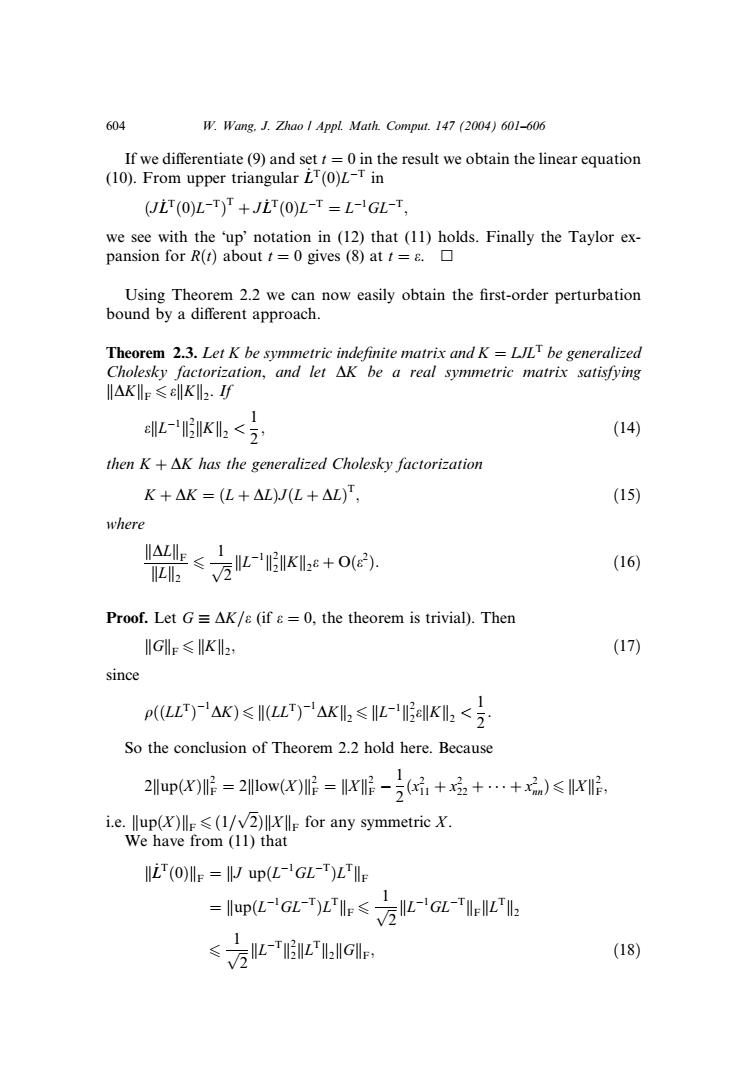正在加载图片...

604 W.Wang.J.Zhao Appl.Math.Comput.147 (2004)601-606 If we differentiate(9)and set t=0 in the result we obtain the linear equation (10).From upper triangular LT(0)L-T in (JLT(0)L-T)T+JLT(0)L-T =L-GL-T, we see with the 'up'notation in (12)that (11)holds.Finally the Taylor ex- pansion for R(t)about t=0 gives(⑧)att=e.□ Using Theorem 2.2 we can now easily obtain the first-order perturbation bound by a different approach. Theorem 2.3.Let K be symmetric indefinite matrix and K =LILT be generalized Cholesky factorization,and let AK be a real symmetric matrix satisfying △Kle≤lK2.If L-K2< (14) then K+AK has the generalized Cholesky factorization K+△K=(L+△L)J(L+△L)I (15) where 先≤方肛s+o (16) Proof.Let G=AK/a(if 8=0,the theorem is trivial).Then IGe≤Kl2: since puAK)≤ILu'aKk≤IL-1lK2< So the conclusion of Theorem 2.2 hold here.Because 2upX)f=2ow(X)呢=XI呢-,++…+)≤X唯, i.e.llup(x)(1/v2)for any symmetric X. We have from (11)that lliT(0)IlE up(L-'GL-T)LTIlE luP(L-GL-)L'GL-TIlLT ≤万L-Il2:lGle, (18)If we differentiate (9) and set t ¼ 0 in the result we obtain the linear equation (10). From upper triangular L_ Tð0ÞLT in ðJL_ Tð0ÞLTÞ T þ JL_ Tð0ÞLT ¼ L1 GLT; we see with the up notation in (12) that (11) holds. Finally the Taylor expansion for RðtÞ about t ¼ 0 gives (8) at t ¼ e. Using Theorem 2.2 we can now easily obtain the first-order perturbation bound by a different approach. Theorem 2.3. Let K be symmetric indefinite matrix and K ¼ LJLT be generalized Cholesky factorization, and let DK be a real symmetric matrix satisfying kDKkF 6 ekKk2. If ekL1 k2 2kKk2 < 1 2 ; ð14Þ then K þ DK has the generalized Cholesky factorization K þ DK ¼ ðL þ DLÞJðL þ DLÞ T ; ð15Þ where kDLkF kLk2 6 1 ffiffiffi 2 p kL1 k 2 2kKk2e þ Oðe 2 Þ: ð16Þ Proof. Let G DK=e (if e ¼ 0, the theorem is trivial). Then kGkF 6 kKk2; ð17Þ since qððLLTÞ 1 DKÞ 6 kðLLTÞ 1 DKk2 6 kL1 k2 2ekKk2 < 1 2 : So the conclusion of Theorem 2.2 hold here. Because 2kupðXÞk2 F ¼ 2klowðXÞk2 F ¼ kXk 2 F 1 2 ðx2 11 þ x2 22 þþ x2 nnÞ 6 kXk2 F; i.e. kupðXÞkF 6 ð1= ffiffiffi 2 p ÞkXkF for any symmetric X. We have from (11) that kL_ Tð0ÞkF ¼ kJ upðL1 GLTÞLTkF ¼ kupðL1 GLTÞLTkF 6 1 ffiffiffi 2 p kL1 GLTkFkLTk2 6 1 ffiffiffi 2 p kLTk 2 2kLTk2kGkF; ð18Þ 604 W. Wang, J. Zhao / Appl. Math. Comput. 147 (2004) 601–606����